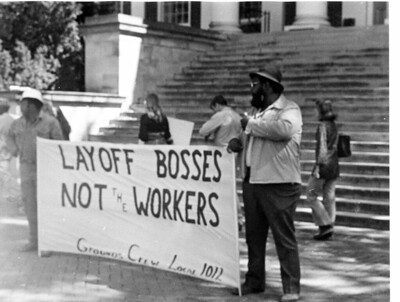Last week, the SUNY Erie Community College Board of Trustees approved layoffs for sixty additional faculty and administrative staff. This follows an earlier termination of ninety custodial and clerical workers at the Buffalo area community college.
ECC’s custodial workers belong to the American Federation of State, County and Municipal Employees (AFSCME) union. Its clerical workers belong to the Civil Service Employees’ Association (CSEA). Custodial workers will be eligible to transfer to other county locations, including the Erie County Medical Center and the Erie County Public Library System.
The newly authorized layoffs will impact sixty faculty and administrative staff members. According to ECC president David Balkin, the moves will decrease the school’s deficit from $9M to $1M. ECC employees were quick to point out that all the “administrative” layoffs affected people in student-facing positions. The planned layoffs do not affect any ECC executives, and the college continues to hire consultants.
In addition, the 150 faculty and staff layoffs, Balkin plans to cut low enrollment programs and consolidate ECC’s activities in 2-3 campus buildings. This would decommission 4-5 buildings on site. Balkin intends to rent or lease these buildings for other purposes. He did not disclose what other purpose he thinks an academic building on a community college campus can have. Recently, Erie County further cannibalized the campus by making the school’s athletic fields available to the Buffalo Bills as part of the county’s plan to build the team a new stadium.
Balkin plans to work more closely with area employers to increase the number of training program ECC provides. To further raise revenues, ECC also announced a 3% tuition increase for the coming academic year.
Layoffs cut capacity but rarely generate success
The Board of Trustees hired President Balkin based on his turnaround of an Ivy Tech Community College campus in Indiana. Employees express doubt that Balkin’s plan – which resembles his efforts in Indiana – will work at ECC.
Layoffs aside, it may not be a community college’s best interest to focus its efforts on third-party training programs for specific employers. First, employers are notoriously fickle when it comes to training and hiring strategies. Second, community colleges can rarely respond fast enough to changes in the area’s economy. If a sudden downturn or unexpected business event drastically changes the employer’s need for employees, the employer can stop hiring immediately, but the community college cannot quickly replace the expected revenue for a bespoke training program. In addition, students trained to meet one employer’s specific needs will not appeal to other employers, even if they are in the same industry. (A downturn that affects one employer in an industry is likely to affect all employers in the same market.)
One reason Balkin stated for the layoffs at ECC was the need to focus on deferred maintenance at another nearby campus. This underscores the importance of conducting consistent maintenance on campus buildings. It is amazingly easy to redirect money intended for capital refreshes to other things. Few people are going to notice, and the roof is not likely to cave in immediately. However, that strategy works only so long. As WCC has seen, delaying capital refreshes does not simply kick the can down the road. It also substantially increases the cost of the work, while simultaneously pushing it toward emergency status.
ECC’s administration has yet to announce its strategy to increase enrollment or create innovative programs that would appeal to prospective students.
Photo Credit: Washington Area Spark, via Flickr
































